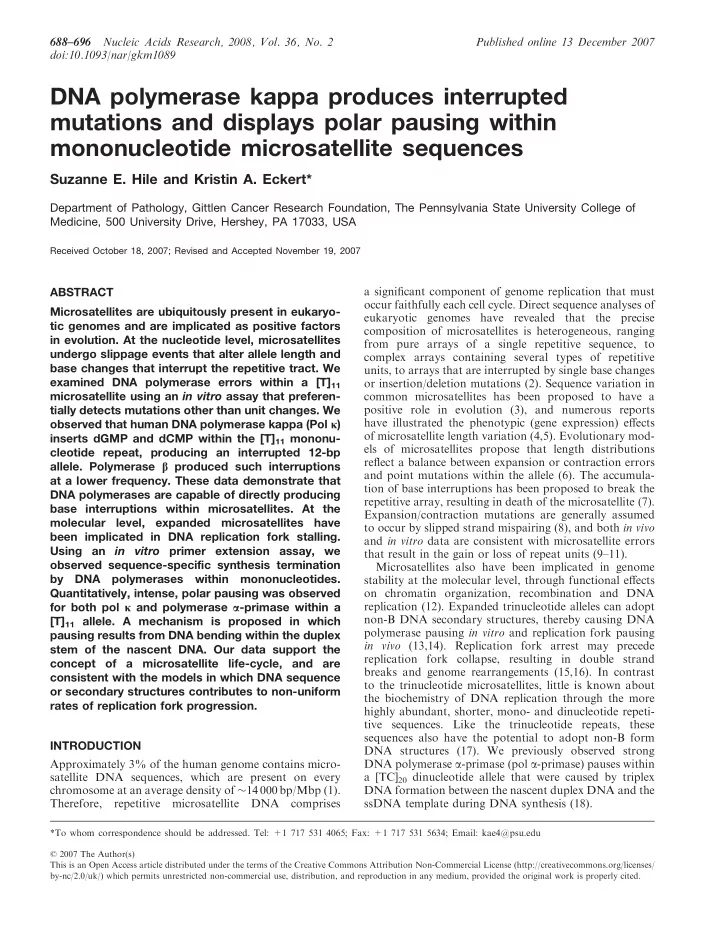

688–696 Nucleic Acids Research, 2008, Vol. 36, No. 2 Published online 13 December 2007 doi:10.1093/nar/gkm1089 DNA polymerase kappa produces interrupted mutations and displays polar pausing within mononucleotide microsatellite sequences Suzanne E. Hile and Kristin A. Eckert* Department of Pathology, Gittlen Cancer Research Foundation, The Pennsylvania State University College of Medicine, 500 University Drive, Hershey, PA 17033, USA Received October 18, 2007; Revised and Accepted November 19, 2007 a significant component of genome replication that must ABSTRACT occur faithfully each cell cycle. Direct sequence analyses of Microsatellites are ubiquitously present in eukaryo- eukaryotic genomes have revealed that the precise tic genomes and are implicated as positive factors composition of microsatellites is heterogeneous, ranging in evolution. At the nucleotide level, microsatellites from pure arrays of a single repetitive sequence, to undergo slippage events that alter allele length and complex arrays containing several types of repetitive base changes that interrupt the repetitive tract. We units, to arrays that are interrupted by single base changes examined DNA polymerase errors within a [T] 11 or insertion/deletion mutations (2). Sequence variation in microsatellite using an in vitro assay that preferen- common microsatellites has been proposed to have a tially detects mutations other than unit changes. We positive role in evolution (3), and numerous reports have illustrated the phenotypic (gene expression) effects observed that human DNA polymerase kappa (Pol i ) of microsatellite length variation (4,5). Evolutionary mod- inserts dGMP and dCMP within the [T] 11 mononu- els of microsatellites propose that length distributions cleotide repeat, producing an interrupted 12-bp reflect a balance between expansion or contraction errors allele. Polymerase b produced such interruptions and point mutations within the allele (6). The accumula- at a lower frequency. These data demonstrate that tion of base interruptions has been proposed to break the DNA polymerases are capable of directly producing repetitive array, resulting in death of the microsatellite (7). base interruptions within microsatellites. At the Expansion/contraction mutations are generally assumed molecular level, expanded microsatellites have to occur by slipped strand mispairing (8), and both in vivo been implicated in DNA replication fork stalling. and in vitro data are consistent with microsatellite errors Using an in vitro primer extension assay, we that result in the gain or loss of repeat units (9–11). observed sequence-specific synthesis termination Microsatellites also have been implicated in genome by DNA polymerases within mononucleotides. stability at the molecular level, through functional effects Quantitatively, intense, polar pausing was observed on chromatin organization, recombination and DNA replication (12). Expanded trinucleotide alleles can adopt for both pol i and polymerase a -primase within a non-B DNA secondary structures, thereby causing DNA [T] 11 allele. A mechanism is proposed in which polymerase pausing in vitro and replication fork pausing pausing results from DNA bending within the duplex in vivo (13,14). Replication fork arrest may precede stem of the nascent DNA. Our data support the replication fork collapse, resulting in double strand concept of a microsatellite life-cycle, and are breaks and genome rearrangements (15,16). In contrast consistent with the models in which DNA sequence to the trinucleotide microsatellites, little is known about or secondary structures contributes to non-uniform the biochemistry of DNA replication through the more rates of replication fork progression. highly abundant, shorter, mono- and dinucleotide repeti- tive sequences. Like the trinucleotide repeats, these sequences also have the potential to adopt non-B form INTRODUCTION DNA structures (17). We previously observed strong Approximately 3% of the human genome contains micro- DNA polymerase a -primase (pol a -primase) pauses within satellite DNA sequences, which are present on every a [TC] 20 dinucleotide allele that were caused by triplex chromosome at an average density of � 14 000 bp/Mbp (1). DNA formation between the nascent duplex DNA and the Therefore, repetitive microsatellite DNA comprises ssDNA template during DNA synthesis (18). *To whom correspondence should be addressed. Tel: +1 717 531 4065; Fax: +1 717 531 5634; Email: kae4@psu.edu � 2007 The Author(s) This is an Open Access article distributed under the terms of the Creative Commons Attribution Non-Commercial License (http://creativecommons.org/licenses/ by-nc/2.0/uk/) which permits unrestricted non-commercial use, distribution, and reproduction in any medium, provided the original work is properly cited.
Recommend
More recommend